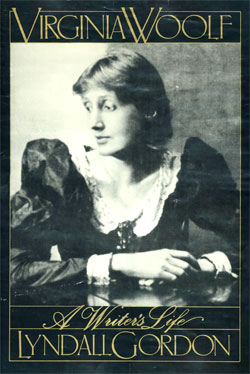Virginia Woolf
From 'Virginia Woolf' in the Oxford Dictionary of National Biography (2004). For fuller details see Virginia Woolf: A Writer's Life.

...She broke with the march of verifiable fact as practised by her father, Leslie Stephen, in the 378 lives (amounting to a thousand pages) which he contributed to the Dictionary of National Biography from 1885,when Virginia was three, until 1901, when she was nineteen. On 3 December 1923, in her forties, his daughter observed in her diary, 'I shouldn't have been so clever, but I should have been more stable, without that contribution to the history of England.' In a biographical dictionary subjects are chosen for their public importance; Virginia Woolf inverts this in her essay 'The Art of Biography' (1939):
The question now inevitably asks itself, whether the lives of great men only should be recorded. Is not anyone who has lived a life, and left a record of that life, worthy of biography - the failures as well as the successes, the humble as well as the illustrious? And what is greatness? And what is smallness?
So, she chose to write on Selina Trimmer who took up her duties as a governess in 1790; on Sara Coleridge who edited the works of her father, the poet; on Flush, the spaniel who shared the sickroom of Elizabeth Barrett and accompanied her when she eloped with Browning; and on Harriette Wilson who, as a courtesan (to, for one, the Duke of Wellington) lived the life of an outcast, winding 'in and out among the bogs and precipices of the shadowy underworld'.
Virginia Woolf's biographical essays took up the challenge of the gaps in such lives - it might be said in all lives - which she approached by accepting that a measure of imaginative truth must co-exist with factual truth. The greater her work, the more completely it takes issue with her father's practice of biography as he edited the Dictionary of National Biography during the first ten years of her life. At the age of five Thoby [her elder brother] had produced a box which he called his 'contra-dictionary box'. Asked the reason for its name, he said it was full of rubbish. Leslie Stephen had discerned gleams of satire. In a sense Virginia Woolf's whole oeuvre was contra-dictionary: her lives of the obscure; the intractable absence of the biographic subject who cannot be deduced from his leavings in Jacob's Room; the unseen inward life of Mrs Ramsay, lit momentarily by the beam of the lighthouse; and invisible presences - the continuing presence of the dead, blurring the formal limits of the lifespan. All forecast possibilities for biography. 'The art of biography is still in its infancy', Virginia Woolf observed in the second draft of The Waves, 'or more accurately speaking, is yet to be born.'
She didn't venture to apply her theories to her one full-scale effort, Roger Fry: a Biography (1940), perhaps because she felt an obligation to the Fry family (who commissioned it) to present the kind of proper, discreet portrait they would expect. In the course of writing this book she groaned under the burden of fact, much as her father had done in the 1880s, locked by his own rulings to the 'drudgery' of 'Dryasdust'. Even so, the daughter, like the father, did exercise the selectiveness that Virginia Woolf advocates in 'The Art of Biography': 'almost every biographer, if he respects facts, can give us much more than another fact to add to our collection. He can give us the creative fact; the fertile fact; the fact that suggests and engenders.'
